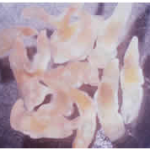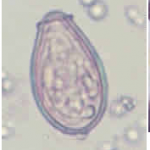Client: EU Commission DG Research FP5 funding.
Project Co-ordinator under contract to the Natural Resources Institute: Ian Watson
Time: 2002 – 2006
The TREMKIT Consortium consisted of the following partners:
- IPD -Institute of Parasitic Diseases, Shanghai, China
- KKU- University of Khon Kaen, Thailand
- MCF- University of Agricultural Science, Mangalore College of Fisheries, India
- NRI -Natural Resources Institute, Chatham, UK
- UD -Heinrich-Heine University, Dusseldorf, Germany
The objective of TREMKIT was to develop DNA and antibody-based diagnostic tools for the detection of three species of fish-borne trematodes, Opisthorchis viverrini(Ov), Opisthorchis felineus (Of) and Clonorchis sinensis (Cs). These diagnostic tools were to be more sensitive than the existing microscopy methods and also more specific in not cross-reacting to other helminths common in endemic areas. Ov is classed as a Class I carcinogen and is responsible for high levels of cholangiocarcinoma where it occurs in SE Asia. Cs also poses health hazards and, as a Class II carcinogen, is implicated in elevated levels of cholangiocarcinoma. Faster, more reliable and more accurate tests for infection in humans will be particularly important for achieving control in areas subject to control measures. In addition, development of diagnostic tools that enable a more precise understanding of the parasite life cycle is an essential step towards understanding the epidemiology of these trematodes and thus identifying potential control points.
Novel DNA extraction and clean-up methods for fish, snails and particularly faeces were developed and resulted in a considerable improvement in the ability to detect both Ov and Cs, both of which are now detectable at much lower levels (10–15 g DNA and 0.5 egg/g faeces) than was previously possible by microscopic examination. The PCR tests were shown to be able to detect patients infected with only one worm. Results from several field trials in Asia also showed that PCR detected Ov infection in 76.6% of patients, who did not have detectable eggs in stool samples suggesting a much higher sensitivity compared to the conventional microscopic examination. A prototype of a freeze-dried kit for PCR diagnosis has been demonstrated to be a viable diagnostic tool.
The second approach was based on polyclonal (PAb) and monoclonal antibodies (MAbs) and was designed to produce a rapid diagnostic test capable of being used in the field to carry out mass-screening of people for trematode infection. PAb antisera and MAb clones generated for Ov and Cs were screened for their sensitivity and specificity and also for growth characteristics. A number of suitable MAb clones were identified and then subjected to more extensive validation. The best MAbs proved to be capable of detecting Ov and Cs antigen in human faeces at very low levels. These MAbs are in the process of being patented by KKU and IPD and discussions are being opened with local enterprises to develop a commercial product. Preliminary trials of adapting selected Ov antibodies into a lateral flow device were carried out.
Key achievements have been:
- The development of monoclonal and polyclonal antisera for the specific detection of Ov and Cs to the stage at which the development of a practical dipstick or lateral flow device for commercial manufacture has been started.
- The development of specific and sensitive primer sets and the subsequent development of PCR optimised protocols that enable detection of infection at levels far below those currently possible with conventional, microscopy methods. The PCR tests were shown to be highly sensitive and patients infected with only one worm can be diagnosed as positive. PCR procedures are applicable for diagnosis of patients in medical health services, and can be used as well for detection of infected fish in control inspections. A prototype of a freeze-dried kit for PCR diagnosis was demonstrated to work.
- The development of extraction and clean-up procedures for use with human faeces. This is a key step in enabling the detection of eggs in people with low level infection which requires a very sensitive PCR. Recent research in Thailand has indicated that low-level infections are frequent in endemic areas and frequently overlooked. Two new techniques for preparation of faecal samples for PCR have been established. Faecal samples containing only one egg react positively. These techniques have great potential to also be useful for the diagnosis of faeces from humans and animals infected with other parasites.
- Rapid and simple methods for the identification of fishes that carry metacercariae of fish-borne trematodes have also been established. The procedures enable the detection of a single metacercariae in a fish sample. Using these techniques, it is possible to inspect edible fishes for their safety with regard to human consumption, e.g. by control authorities.
Publications and postgraduate training
GenBank submissions of sequence data on Clonorchis sinensis (7 sequences, GenBank Accession number AY586613- AY586618) and Opisthorchis viverrini (8 sequences, GenBank Accession Number AY786353- AY786359 and AY584735). These are unique sequences with no homology to the sequences presently available in the database.
Dong YT, Feng Z. (2003). Advance in research on immunodiagnosis and molecular biology of Clonorchis sinensis. Parasitic Diseases Foreign Medical Sciences 30: 108-113
Chen X, Feng Z, Qiu LZ. (2004). Advance in research on diagnosis of Opisthorchis
viverrini. Parasitic Diseases Foreign Medical Sciences 31: 1-5
Lu JY, Xu XN. (2006). Advance in research of PCR detection for food-borne trematode. Parasitic Diseases Foreign Medical Sciences 33: 105-109
Ammini Parvathi, H. Sanath Kumar, B. Kenchanna Prakasha, Jieyuan Lub, Xuenian Xub, Wei Hub Zheng Feng, Indrani Karunasagar and Iddya Karunasagar . (2007).
Clonorchis sinensis: Development and evaluation of a nested polymerase chain reaction (PCR) assay. Experimental Parasitology 115 (3): 291-295
Ammini Parvathia, Kanasinakatte R. Umeshaa, Sanath Kumara, Paiboon Sithithawornb, Indrani Karunasagara, Iddya Karunasagar (2008) Development and evaluation of a polymerase chain reaction (PCR) assay for the detection of Opisthorchis viverrini in fish. Acta Tropica 107(1): 13-16
Boris Müller, Jürgen Schmidt, Heinz Mehlhorn (2007) Sensitive and species-specific detection of Clonorchis sinensis by PCR in infected snails and fishes. Parasitology Research 100 (4) : 911-914





